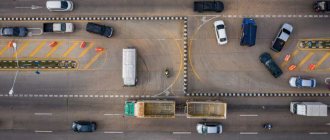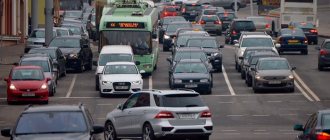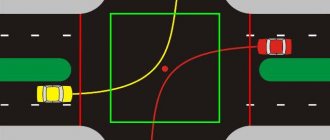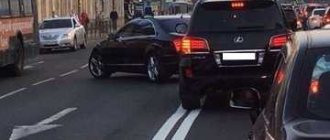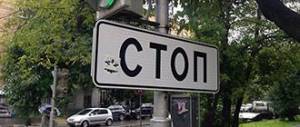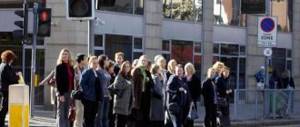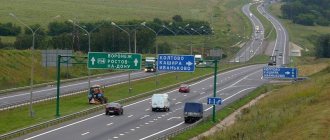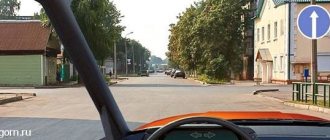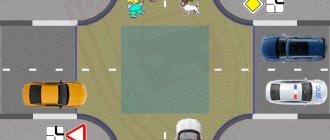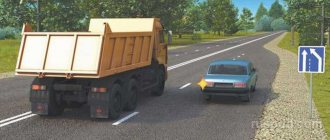Is it possible to turn around at the “Left Turn” sign (symbol 4.3.1): changing the direction of travel to the opposite is done in a certain way. You need to turn to the left, and then in the same direction again. That is, where 4.3.1 is installed, it is not forbidden to drive in the direction opposite to the previous direction of movement. Unless, of course, there is also a sign prohibiting a turn in this zone (3.19).
4.3.1 can be installed at or outside the intersection. This does not change the meaning of the road symbol - it prescribes a change in the trajectory of movement only in accordance with the direction of the arrow.
Signs prohibiting left turns:
- 3.18.2 restricts traffic in this direction; you can drive in all other directions, including the opposite direction;
- 4.1.1, 4.1.2, 4.1.4 are instructed to move only where the arrow points;
- 5.7.1 (blue rectangle with a white arrow) informs that drivers find themselves on a one-way road, they can only go to the right, it is not prohibited to turn around in the area where the sign is valid;
- 5.13.1 informs that the road going to the left is intended for public transport, ordinary cars and motorcycles are prohibited from driving along it, and turning off is also prohibited;
- 6.3.1 allows you to turn around, in fact, it designates the place where the maneuver can be performed, but only it is allowed here;
- 6.3.2 – designation of the territory intended for turning around, providing the opportunity to turn around and prohibiting all other actions.
Signs that allow left turns , in addition to 4.3.1:
- 4.1.5 you can go straight or deviate to the side, obeying the instructions of the arrows located on the field, you cannot go to the right;
- 4.1.6 prohibits straight movement, but allows turning in both directions;
- 5.7.2 installed at an intersection where it is impossible to go to the right;
- 5.13.2 They are installed where the path going to the right is intended only for public transport, everyone else must go either straight or to the left of the intersection, you can turn around.
has one feature - it is not valid for all road users: it allows public vehicles, minibuses, to drive in a different direction.
Rules for crossing intersections may differ depending on what kind of intersection it is. In this case, if the main road changes trajectory at an intersection, you need to drive through it as if all intersecting paths are equivalent. At the intersection of equivalent roads, the “right hand” rule applies.
The fine for turning left under sign 3.18.2 is 1000-1500 rubles. The same punishment awaits the driver if he performed the maneuver without paying attention to the markings. The violation may also consist of:
- When marked 4.3.1, the driver drove to the right or straight - a fine of 500 rubles.
- Under the designation 5.13.1, he turned left and found himself in a lane allocated for public transport - a fine of 1,500 rubles, and if this happened in the capital or St. Petersburg - 3,000 rubles.
More on AutoLex.Net:
Parking, stop and parking signs
Read more in our article about the “Left Turn” sign.
In this article:
No left turn sign 3.18.2
The purpose of this sign is to bring order to traffic on busy streets.
Often on problem sections of the road there is the possibility of a long “traffic jam” due to driving to the left. To prevent congestion, a no left turn sign is installed, in the shape of a white circle outlined by a red line. In the middle there is a crossed out curved arrow indicating that movement on the left side is prohibited. The practical expediency of such signs sometimes leaves something to be desired.
Violating the left turn rules will result in a fine of 1,500 rubles.
No left turn sign, is a U-turn allowed?
Figure 1
Prohibiting turn sign 3.18.2 according to clause 3.19 of the Russian Traffic Regulations allows the vehicle to turn.
If there is a need to move in other directions, feel free to turn around. You will not commit an administrative offense by doing so.
The sign is only at the nearest road intersection, but not at the intersection, where there are many more of them (see Figure 1).
Traffic rules and sign “Main road turn left”
Rules for crossing intersections may differ depending on what kind of intersection it is. And many problems arise when they are unequal. Especially where the sign “Turn the main road left” is installed. Actually, in this case there should be two of them: 2.1, indicating the priority of the path, and 8.13, indicating its direction (to the left of the main one). Sections 13.10 and 13.2 of the Traffic Regulations will tell you how to move in this case:
- If the main road changes path at an intersection, you must drive through it as if all intersecting paths were equivalent. This also applies to those moving through the secondary.
- At the intersection of equivalent roads, the “right hand” rule applies. It means the need to give way to someone approaching from this direction. That is, a car in the direction of which another vehicle is traveling on the right must slow down and wait.
The presence of sign 8.13 is also possible next to symbols 2.4 (requirement to give way) and 2.5 (prohibiting movement without stopping). In these cases, those vehicles traveling on the main route have priority.
More on AutoLex.Net:
In Russia they want to install smart traffic lights
Mandatory signs 4.1.1, 4.1.2 and 4.1.4
Installed signs 4.1.1, 4.1.2, 4.1.4 prescribe movement at the intersection and along the road section in the direction indicated by the white arrow on the sign and are valid until the first intersection or entrance to the adjacent territory.
- Sign 4.1.1 - allows movement only straight, movement to the right, left and turning is prohibited.
- Sign 4.1.2 - allows you to turn right, but turning around, moving straight and to the left is prohibited.
- Sign 4.1.4 - allows movement straight and to the right, but U-turns and turns to the left are prohibited.
Which signs allow turning and which do not?
It is not always possible to turn left at an intersection, even if there is a road. There are symbols that do not allow the maneuver. Here are the signs prohibiting left turns:
- 3.18.2. It directly restricts movement in this direction. You can travel in all other directions, including the opposite direction; the ban does not apply to them.
- 4.1.1, 4.1.2, 4.1.4. The symbols instruct you to move only where the arrow points. That is, respectively, straight, to the right and in both these directions. Everything else in the territory of their operation is considered a violation. Turning left at a “Straight” or “Right” sign will end in at least a punishment for the driver, and in the worst case, a collision with another vehicle. And the one who neglected the requirements of the symbol will most likely be found guilty of the incident.
- 5.7.1. Informs motorists that they are on a one-way road. The symbol is a blue rectangle with a white arrow pointing to the right. This is the only direction you can go. It is not prohibited to turn around in the area under 5.7.1.
- 5.13.1. The symbol informs you that the road going to the left is intended for public transport. This is a “separate road” on which ordinary cars and motorcycles are prohibited. It is impossible to turn under 5.13.1 to the left precisely for this reason.
- 6.3.1. The symbol allows you to turn around; in fact, it indicates the place where the maneuver can be performed. But only he is allowed here. And you can’t turn left in coverage area 6.3.1.
- 6.3.2. This is a designation of the territory intended for turning around. It can be larger in area than that limited by the previous symbol. But the meaning of 6.3.2 is the same as 6.3.1, that is, providing the opportunity to turn around and prohibiting all other actions.
More on AutoLex.Net:
How to figure out what is a detour and what is overtaking?
But what signs allow a left turn, in addition to 4.3.1:
- 4.1.5. You can drive straight under it or deviate to the side, following the instructions of the arrows located on the field. It is no longer possible to go to the right.
- 4.1.6. It prohibits straight movement. But it allows you to turn in both directions.
- 5.7.2. The symbol is installed at an intersection where you cannot go right. But in the opposite direction it is possible.
- 5.13.2. Such a sign is installed where the path going to the right is intended only for public transport. Everyone else must go either straight or to the left of the intersection. You can also turn around here.
4.3.1 has one peculiarity - it is not valid for all road users. The “Turn Left” sign allows public transport and minibuses to travel in a different direction.
Signs 6.3.1 and 6.3.2 prohibiting left turns
Information signs 6.3.1 and 6.3.2 are installed to the left of the direction of movement of the vehicle to indicate and inform about approaching a section of the road where signs allow a U-turn:
- Sign 6.3.1 - is installed in front of a section of the road where a left turn is permitted.
- Sign 6.3.2 - is installed in front of the road section and indicates the area where it is allowed to make a left turn.
According to the traffic rules, signs 6.3.1 and 6.3.2 prohibit turning left and allow movement in other directions (as many as possible).
Sign 3.18.1 “Right turn prohibited”
Road sign 3.18.1 “Turn right is prohibited” is used to prohibit turning right at the nearest intersection of roadways in cases where the required traffic order cannot be ensured with the help of mandatory signs 4.1.1 - 4.1.6 or traffic direction signs along lanes 5.15.1, 5.15.2.
The “No Right Turn” sign is valid for the first intersection of roadways in front of which it is installed. The sign does not apply to route vehicles.
You can read about what a “Route Vehicle” is in the article Priority of Public Transport.
Sign 3.18.1 only prohibits right turns. Driving straight, turning left and making a U-turn (if there is a technical possibility for the listed movement options and they do not contradict the traffic rules) are NOT prohibited.
The yellow background of the “No Right Turn” sign means that the sign is temporary. Such signs are installed at road work sites.
6.3.1 "Turning space"
April 10, 2013 Administrator Home page » Road signs Views:
Modern roads have fairly wide carriageways with very heavy vehicle traffic.
Very often, the passing and oncoming directions of traffic are separated by a solid (single 1.1 or double 1.3) marking line or dividing strip, which strictly prohibit making a U-turn.
And under these conditions, the driver, who is in dire need of a turn, will be forced to move in a direction that is irrelevant to him, without being able to perform the maneuver that interests him.
What if this is a highway, and the nearest overpass is several tens of kilometers away? What is this “perspective” for you?
That is why traffic control has a life-saving mechanism in its arsenal. The road sign “Place for a U-turn” is precisely used to indicate the place on the roadway where the driver is allowed to make a U-turn.
Agree, a very convenient sign. It means that the traffic organizer in this area has taken care of either creating a break in the dividing strip, or drawing a broken marking line, etc. Do you dream of turning around? Please!
Now let's say a few words about how to install a sign.
It is important to note that the “Turning Place” sign is not posted at an intersection where a U-turn is permitted according to the Rules. Its installation location is a section of the road between intersections.
The sign can be installed:
- Above the leftmost lane (from which, in fact, a turn will be allowed);
- On the dividing strip (if any) - before the dividing strip breaks;
- On the right side of the road (if the number of lanes in the same direction does not exceed three; that is, the roadway is not so wide).
The rules also provide for the installation of a preliminary sign “Place for a U-turn” in combination with a sign “Distance to the object” (8.1.1).
It is not difficult to understand this combination of signs: after the distance indicated on the sign along the route there will be a place for a turn. In this case, drivers will be informed in time about the opportunity to turn around.
And now - THE MOST IMPORTANT THING!
The “U-Turn” sign, despite being an informational (not prohibiting anything) sign, is VERY INSANE!
And his cunning lies in the fact that HE STRICTLY PROHIBITS LEFT TURN! For example, in the courtyard, residential area, gas station and other territory adjacent to the left.
The “U-turn space” sign seems to tell the driver: “There is a ROOM HERE ONLY FOR A U-turn, but not for making a left turn.” Agree, otherwise this section of the road could be mistaken for an intersection.
Thus, the “Turn Place” road sign allows the driver to make a U-turn (or continue driving in the same direction), but it STRICTLY PROHIBITS LEFT TURN. Remember this requirement, please, and do not make an annoying mistake.
If this information was useful to you, please write about it in the comments. If you have any questions, write, I will definitely try to help you.
Traffic regulations online from the autoass team!
The content of the article:
- U-turn sign
- U-turn sign
- sign 6 3 1
- turning space
Tags: place to turn
Where to look for the answer to a question
For the driver, the “holy scripture”, on compliance with the norms of which life and material well-being in this world often depends, are the Road Traffic Rules of the Russian Federation. This document displays all the rules regarding the order of crossing signalized and uncontrolled intersections.
In particular, on the pages of the publication there are instructions for drivers who are faced with the dilemma of turning around at an intersection where there is a sign that prohibits turning left.
Paragraph 8.11 of the traffic rules clearly indicates sections of the road where such a maneuver is prohibited. In a fairly large list of restrictions, there is not a word that a sign that prohibits turning left has any effect on the ability to make a U-turn.
To make sure you are right, you should look for the paragraph in the Traffic Rules regarding the operation of sign 3.18.2. The description for this element explains that its presence on the road does not prohibit turning.
Signs and prohibitions
Signs installed in front of certain sections of roads may prohibit, inform, recommend (prescribe) specific types of vehicle maneuvering.
Information signs, the purpose of which is to warn the driver in advance about the possibility of making a U-turn, include “Turn Zone” and “Turn Place”. They are installed above the leftmost lane in the direction of traffic, no matter whether there is a dividing strip on the roadway or not. As an exception, these signs can be installed on the right side, but only if the roadway has no more than three lanes in one direction.
U-turn zone sign
In this case, to warn the driver in advance, preliminary signs indicating the distance to these objects are installed in front of the zone and place for a turn at a distance of at least one hundred meters.
The “Turn Zone” sign indicates a specific area where you can make a maneuver, guided by the markings. “A place for a turn” is different in that it not only warns about the possibility of a turn, but additionally informs about the length of the road section intended for this.
On sections of roads where, as a result of a U-turn or turn to the left, problems may arise for the movement of passing, oncoming traffic or pedestrians, traffic rules limit these maneuvers with the help of signs:
- “Left turn prohibited” – does not set a ban on turning;
- “Turn prohibited” - indicates only the impossibility of a turn and does not affect turning left;
- “Exit onto a road with a lane for route vehicles” - in those places where the direction of movement of all transport, except route vehicles, is from left to right, that is, oncoming traffic for turning left.
No left turn allowed
The last of those listed refers to those that do not prohibit, but order not to perform a maneuver that violates traffic rules.
Such signs include those that are advisory in nature and indicate:
- moving straight and to the right, only straight or only to the right - indicate the impossibility of turning around and turning left;
- moving straight or to the left, only to the left - you are allowed to make a left turn and a U-turn;
- movement to the right or left - allow you to maneuver in any direction except continuing to move in a straight line;
- direction of movement along the lanes - informs which lane you can move in to perform the desired maneuver.
